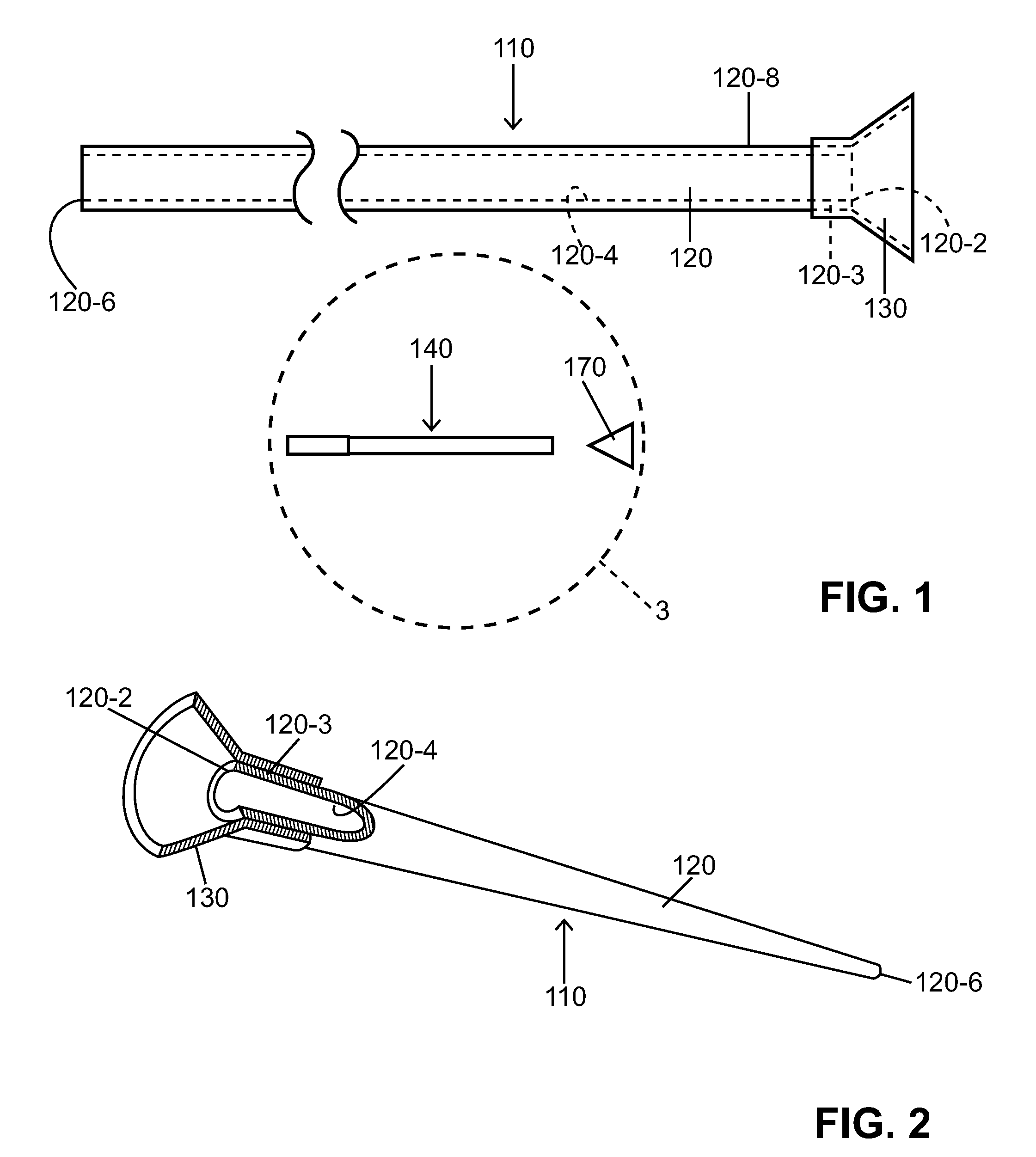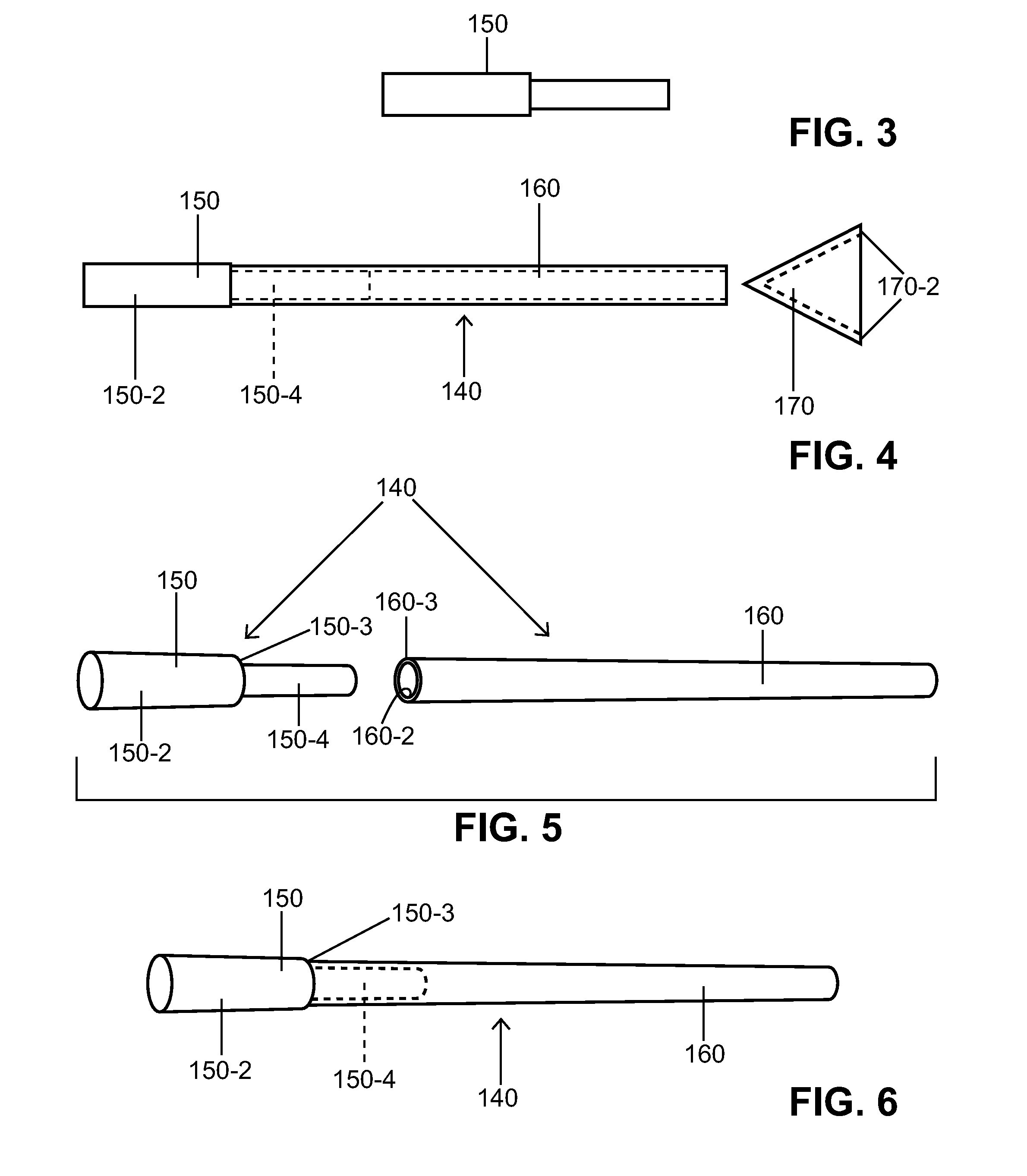Furthermore, Gaylord does not disclose or contemplate alternative embodiments or methods of use in which such a projectile
detent is used to help locate elements of a sabot projectile
assembly within the bore and in
spatial relation to one another.
However, like Gaylord, Thompson does not disclose alternative embodiments or methods of use in which such a projectile detent is used to locate one or more elements of a sabot projectile
assembly.
Furthermore, Thompson's type of fingertip detent, although an elegant solution for the peashooter and projectile he discloses, would not be generally applicable to a wide variety of types of blowgun projectiles, particularly certain types of sabot projectiles that include subcaliber projectiles.
However, Walker makes no provision for a detent to prevent premature sliding of the dart within the bore.
Nor would the
tranquilizer dart described by Walker
exploit the full possibilities of substantial
caliber reduction to provide a projectile with sufficiently high sectional density to confer substantial trajectory advantages for long range application.
Nor are disclosed alternative embodiments to the
tranquilizer dart suitable for general sporting applications including target shooting and hunting.
However, Jacobs does not disclose any way to use his blowgun to launch elongate subcaliber projectiles which could be more effectively adapted to exhibit high sectional densities in-flight.
However, if
small caliber shot such as BB shot were launched as full
caliber projectiles, the correspondingly small barrel bore would excessively
restrict the inflow of the user's breath.
On the other hand, at larger caliber sizes, full caliber
metal shot would generally be excessively massive for thrust provided by a user's breath.
However, the shot-retention lip and self-centering cavity of the carrier disclosed by Jacobs would not work effectively with elongate projectiles.
Jacobs also does not disclose any provision to provide the bore with an interior guidance groove to apply enhanced guidance to the shot-projectile or other projectile during launch.
Suitable means must be utilized so that various other sources of resistance to launching, sabot disengagement, and sabot discarding are simultaneously limited to acceptable levels compatible with available thrust.
The applicant knows of no prior-art blowgun able to simultaneously achieve or deliver all of these objects or advantages.
Prior-art blowguns were unable to efficiently launch subcaliber projectiles, and were therefore limited to effective use with full caliber projectiles.
Full caliber projectiles, in order to be propelled by the relatively low operating pressures typically provided by a human user's breath, are required to have relatively low sectional densities, since a full caliber projectile with excessively high sectional density would be excessively massive for the available thrust and would thus be accelerated
too slowly, achieving low exit velocities, poor trajectories, and probably causing discomfort or strain to the user's airways and lungs.
The low sectional density and correspondingly low ballistic coefficients of full caliber blowgun projectiles means that their trajectories are excessively curved, particularly at extended ranges, making maximum range limited and causing targeting compensation at extended ranges to be very difficult due to the large amount of barrel elevation needed to compensate for the excessive amount of vertical drop of the projectile.
Using full-caliber projectiles of lighter
mass to achieve higher velocities and flattened trajectories may yield
improved performance at close ranges, but at extended ranges trajectory will still be excessively curved, since lightening the
mass but keeping the caliber constant results in even lower sectional density.
Another problem encountered with full caliber blowgun projectiles is a severe limitation in the ability to adjust projectile properties such as form factor,
mass distribution, and configuration of aerodynamic surfaces, in order to improve aerodynamic performance and balance to yield benefits such as reduced drag, reduced sensitivity to cross-winds, increased
ballistic coefficient, and improved stability and accuracy.
This severe limitation is imposed by the requirement that some fixed portion of the projectile must be suitably shaped and sized to serve as a substantially full caliber
piston slidingly sealable with the bore of the blowgun barrel.
Due to the problems set forth above, prior-art blowguns achieved only limited performance.
Inadequate ability to improve projectiles in terms of characteristics such as sectional density, form factor,
ballistic coefficient,
mass distribution, balance, configuration of aerodynamic surfaces, and internal ballistic stability caused significant reduction of the benefits that were intended to be provided by prior-art attempts to improve performance.
However, the fact that full caliber projectiles still often had surprisingly low sectional densities and correspondingly poor ballistic coefficients meant that projectile velocity decreased very rapidly in flight, with the result that maximum range remained limited, and trajectories, particularly at extended ranges, remained excessively curved, so that long range targeting compensation was still very difficult due to excessive vertical drop of the projectile, while other problems included tendencies towards balance- and aerodynamic-related
instability, along with various sources of inconsistency in the orientation and motion of the projectile as it was launched into flight.
Additionally, the above problems with prior-art blowguns and projectiles tended to encourage methods of use which did not sufficiently customize blowguns and projectiles for each particular user's abilities, skills, and shooting objectives.
However, despite the advantages described above, sabot projectile solutions have not been effectively employed in prior-art blowguns, due to the fact that prior-art sabot projectiles are not adapted to be launched efficiently within the range of operating pressures that may be typically provided by human breath.
Furthermore, discarding of prior-art sabots does not operate efficiently within the range of velocities typically attainable by blowgun projectiles.
Sabots utilized in
artillery are often somewhat structurally complex, especially if the subprojectile has a very substantial caliber reduction relative the bore caliber.
Such high levels of launching resistance and discarding resistance are not able to be overcome efficiently, if at all, by the much lower operating pressures provided by human breath, and by the considerably lower velocities and energies attainable by blowgun projectiles launched by human breath.
However, it is problematic to apply barrel
rifling to blowguns without excessively increasing launching resistance.
First, inadequate operating pressures to overcome launch resistance would result in the sabot projectile either being stuck in the barrel bore, or else exiting the barrel bore with reduced velocity.
Second, in the event the sabot projectile did attain satisfactory exit velocity, since satisfactory velocities for blowgun projectiles are still typically too low to actuate discarding of prior-art sabots, there would likely be a failure of the sabot to achieve separation and thereby discard, in which case the sabot means and the subcaliber projectile would continue to travel along an external trajectory together, performing in effect as a full caliber projectile and causing the subcaliber projectile to fail to achieve its true function.
Even if separation occurred, release would likely not be quick and clean, thus transmitting excessive drag from the sabot means to the subcaliber projectile during discarding, thereby lowering projectile velocity, or introducing trajectory inaccuracies for the projectile, or both.
Third, even if the degree of discarding resistance were lowered sufficiently to guarantee successful, clean discarding of the sabot means, the consequent looseness or tenuousness of the connection between the sabot means and the projectile proper would almost certainly result in premature separation of the sabot projectile components prior to launch acceleration or prior to exit from the barrel bore.
It will be apparent to one familiar with the art that even the airgun-compatible sabot utilized in U.S. Pat. No. 5,150,909 to Fitzwater would not operate successfully or efficiently at pressures provided by human breath.
Blowgun pressure differentials, however, are generally even more modest, probably never or rarely exceeding 4
pounds per square inch (psi), with 2 psi and lower being much more typical for the average user.
Such a solution may not appeal to those blowgun users who prefer to use their own breath to provide the motive force to accelerate and launch the projectile, rather than rely on an external motive source such as a canister of pressurized gas.
Lala does not disclose, describe, or contemplate any alternative embodiments capable of launching subcaliber projectiles.
This point is very important, because at the relatively low velocities and energies which blowgun projectiles typically attain, it may be surprisingly difficult to obtain separation, or clean separation, of the sabot from the subcaliber projectile if there is even a seemingly tenuous connection between the two components which would excessively
resist the type of relative
axial displacement described in the preceding
sentence.
Thus, there is the potential for even a seemingly weak force-fit engagement, frictional engagement, or the like, to be able to either cause failure of the sabot to separate at all or else cause sabot separation to either be too slow or too violent, thereby transmitting drag or trajectory inaccuracies or both to the projectile proper.
However, none of these patents disclose alternate embodiments or methods of use in which such a magnetic bolt, breech pin, or hold-down device is used to locate an element of a sabot projectile
assembly preparatory to firing; and in particular to hold a subcaliber projectile in place against, within, or in front of a sabot means in loaded disposition pending launch.
Another
limiting factor in the performance of prior art blowguns is that insufficient correctional guidance is applied to certain portions of the projectile during launch acceleration, resulting in internal ballistic
instability that translates into accuracy dispersions in the projectile's external trajectory.
Certain prior art designs attempted to address this problem, but the means employed resulted in increased launch resistance, increased projectile mass, and undesirable aerodynamic and balance characteristics of the projectile.
However, many typical commercial blowgun darts do not utilize a cylindrical
piston body, but rather a
piston body that is essentially conical, and which usually does not maintain the longitudinal axis of the dart in alignment with the longitudinal axis of the barrel bore.
Prior art blowguns also presented certain disadvantages concerned with target shooting.
Prior art practices for shooting blowgun projectiles at targets and retrieving projectiles from the targets suffered from an excessively
high potential for damage to projectiles, which are typically intended to be reusable, and from excessive amounts of time and effort spent in retrieving projectiles from the target after a round of shooting.
Prior art practices also placed limitations on accuracy of assessment of shot placement on the target face, and made it difficult to practice more than a rather narrow variety of target practice shooting styles and formats.
Prior art blowguns also presented problems in launching spherical projectiles, and certain other essentially non-elongate projectiles, since full caliber spherical projectiles typically had relatively high sectional densities and poor air seal performance, resulting in poor launch acceleration and reduced velocities.
 Login to View More
Login to View More  Login to View More
Login to View More 


